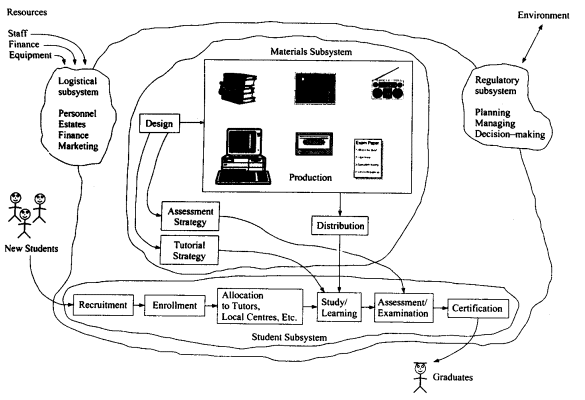|
A
generic template for costing ODL
Keegan's definition
of distance education includes the following elements:
(based on Keegan (1990, p.14); emphasis added) This definition
can be interpreted under the perspective of developing a generic costing
template for ODL systems: While (1) provides a sort of 'minimalist definition'
of ODL which is to be elaborated in the subsequent points, (2) marks
the importance of a providing institution. In terms of cost-analysis
this corresponds to the institutional overheads or (with respect to
courses) indirect costs. (3) refers to the cost drivers of course development,
which are direct costs. (4) refers to the direct costs of course presentation
(delivering the study material and supporting students' learning). (There
is a fifth point stipulating the quasi permanent absence of a group
in the process of learning which became obsolete in times of CMC and
videoconferencing.) Rumble
(1997) identifies four systems: the materials subsystem, the students
subsystem, the logistical and the regulatory subsystems. Figure
1: Distance education - a rich picture If we focus on the two main subsystems while keeping in mind the definition of distance education, the following format seems appropriate for reporting costs: The activities in the materials subsystem, these relate to the development of course materials which a redistributed to the learner via different media such as printed study guides, audio or video tapes, or CD-ROMs. Course material development costs will be a main heading in our costing template. These are essentially fixed costs. The cost drivers for materials development depend very much on the media used. For print based courses the main costs are:
Since most other media include at least some printed complementary material, authoring and layout are cost drivers in almost all cases. Radio or TV production involves all sorts of media specialists. In both cases production overheads may have to be included if the production facilities are located in the institution. Using computers
may involve high programming costs, especially if multi-media materials
are developed. On the other side, if computers are used mainly for communication
purposes, development costs are lower since commercially available platforms
provide the necessary facilities. ODL includes the costs of two-way communication to support the learner (Keegan, 1990). In the following we call the process of teaching a course (based on the pre-prepared materials) 'course presentation', which includes all the costs of tutoring and student support. The course presentation costs will be a further main heading in our costing template. The costs of student support depend strongly on the number of students in the system. Generally, the costs of student support are variable costs. Typical cost drivers
are tutor marked assignments (TMAs), counselling and tutoring. Costs
will also be affected by whether students are to learn individually
or in groups. Even in traditional correspondence courses there are often
options to join evening classes at regional learning centres or enrol
in summer schools (e.g. to prepare for examinations). Indirect
costs (overheads) There are a number of costs, which do not arise directly from a specific course. Such costs are classified as 'indirect costs' or 'overheads'. They include buildings (such as offices), equipment (servers, radio transmitters) or services (cost of the director). Whether such costs should be included when budgeting for a particular course will depend on the purpose of the costing exercise; how they are to be treated depends on the nature of the respective cost driver (e.g., a capital or an operating cost). Obviously, in a
full cost-analysis, indirect costs should be included. However, when
budgeting for a particular course or when comparing courses with different
combinations of media, overhead costs can sometimes be ignored since
they do not affect the comparative cost of the different approaches.
If overheads are to be included they then have to be shared in some
way between the different courses. Sharing out overheads is a fairly
complex activity and may involve methods such as 'activity based costing'
(ABC). Generic
costing template The above classification can be taken as a generic costing template for ODL. There are the indirect costs relating to the institutional overheads, and the direct costs for (1) the development of materials, and (2) the costs of course presentation. If we measure the volume of activity by the number of students enrolled in the courses, costs of development are fixed (i.e. they do not change as the number of students changes), while costs of course presentation vary strongly with the volume of activity (i.e., the larger the number of students, the larger the presentation costs become). This will be an important point to remember when the cost-structure of ODL is analysed in terms of the composition of fixed and variable costs. This background
allows us to produce our first generic template (Table 1).
. Table 3: Costing template (cost projection)
|
||||||||||||||||||||||||||||||||||||||||||||||||||||||||||||||||||||||||||||||||||||||||||||||||||||||||||||||||||||||||||||||||||||||||||||||||||||||||||||||||||||||||||

